brake sensor FORD FIESTA 2007 Owner's Guide
[x] Cancel search | Manufacturer: FORD, Model Year: 2007, Model line: FIESTA, Model: FORD FIESTA 2007Pages: 1226, PDF Size: 61.26 MB
Page 549 of 1226
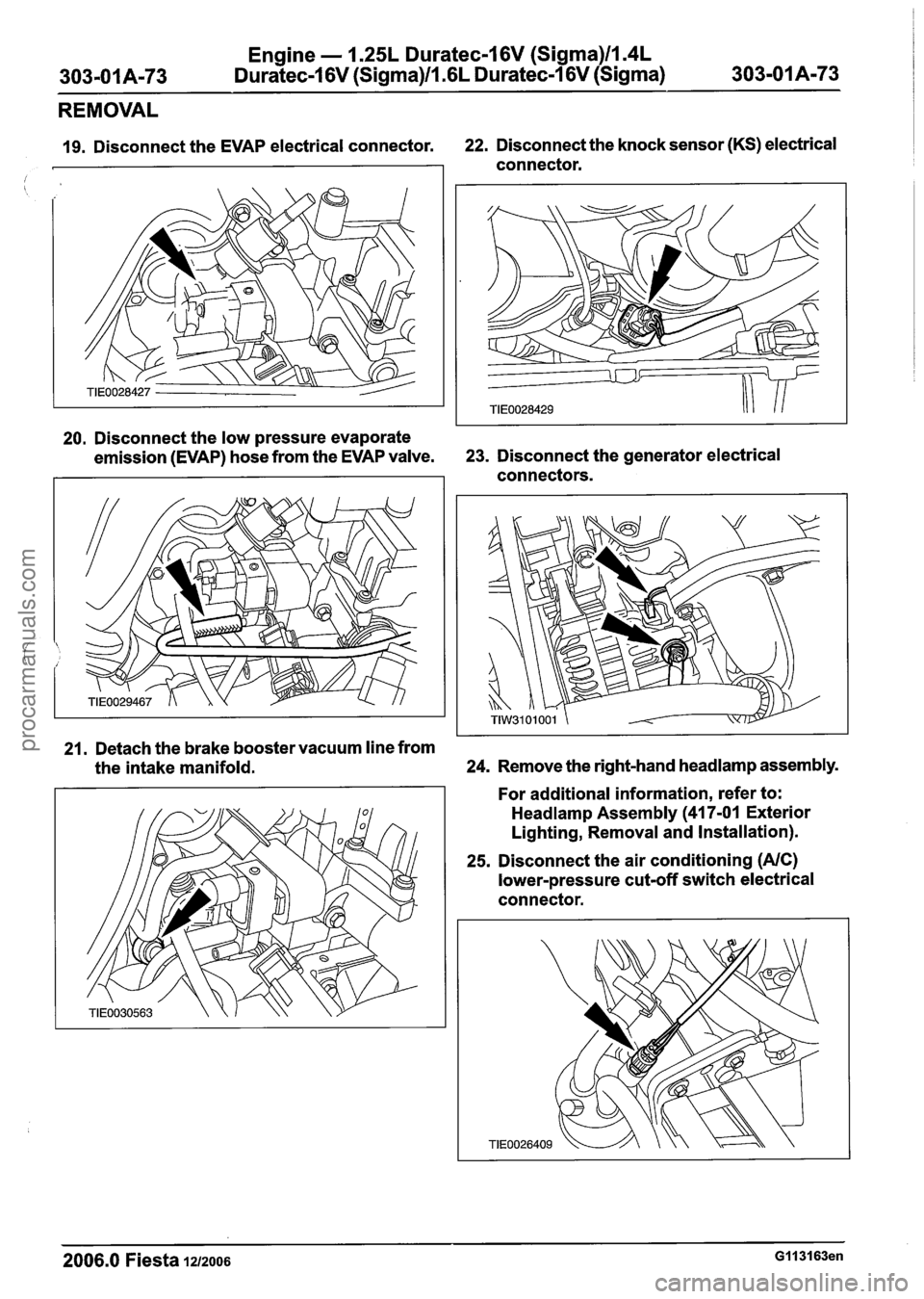
Engine - 1.25L Duratec-1 6V (Sigma)lIl4L
Duratec-1 6V (Sigma)ll .6L Duratec-1 6V (Sigma)
REMOVAL
19. Disconnect the EVAP electrical connector. 22.
Disconnect the knock sensor (KS) electrical
connector.
20. Disconnect the low pressure evaporate
emission (EVAP) hose from the EVAP valve. 23.
Disconnect the generator electrical
connectors.
21. Detach the brake booster vacuum line from
the intake manifold. 24.
Remove the right-hand
headlamp assembly.
For additional information, refer to:
Headlamp Assembly (41 7-01 Exterior
Lighting, Removal and Installation).
25. Disconnect the air conditioning
(AIC)
lower-pressure cut-off switch electrical
connector.
2006.0 Fiesta 1212006 GI 131 63en
procarmanuals.com
Page 560 of 1226

Engine - 1.25L Duratec-1 6V (Sigma)llm4L
Duratec-I 6V (Sigma)ll .6L Duratec-1 6V (Sigma)
REMOVAL
13. Disconnect the low pressure evaporate 16. Using the special tool, disconnect the
emission
(EVAP) hose from the EVAP valve. coolant hose from the coolant distribution
housing.
14. Detach the brake booster vacuum line from
the intake manifold.
17. Disconnect the heated oxygen (HOZS)
sensor electrical connector.
15. Using the special tool, disconnect the
coolant hose from the coolant distribution
18. Disconnect the catalyst monitor sensor
housing. electrical connector.
2006.0 Fiesta 1212006 G380458en
procarmanuals.com
Page 821 of 1226

Fuel Charging and Controls - 2.OL
303-04B-13 Duratec-HE (M14) 303-04B-13
DIAGNOSIS AND TESTING
Possible Sources Action
,
Engine ignition.
Symptom
Engine stumbling
Engine lacks power
REFER to: Engine lgnition
(303-07B, Diagnosis and
Testing).
Fuel injectors.
INSPECT the fuel injectors.
CLEAN the fuel injectors or
INSTALL a new set of injectors
as required only after the
checks have been carried out.
Low fuel system pressure.
EGR valve sticking open.
Check the fuel system pres-
sure.
REFER to: Fuel System Pres-
sure Check (31
0-OOA,
General Procedures).
Fuel rail fuel pressure sensor.
REFER to: Engine Emission
Control (303-08 Engine
Emission Control
- 2.OL
Duratec-HE (M14), Diagnosis
and Testing).
Carry out a full engine
diagnosis using the guided
diagnostic menu in WDS.
Engine ignition. REFER to: Engine lgnition
(303-07B, Diagnosis and
Testing).
Brakes binding.
I CHECK the braking system.
REFER to: Brake System (206-
1 00, Diagnosis and Testing).
Vehicle overloaded, or
excessive wind resistance (roof
racks, towing etc). ADVISE
the customer about
the effects of overloading the
vehicle and wind resistance on
the fuel consumption.
Air cleaner element blocked.
REFER to: Fuel System Pres-
sure Check (31
0-OOA,
General Procedures).
INSTALL a new air cleaner
element as necessary.
Low fuel system pressure.
r
Check the fuel system pres-
sure.
2006.0 Fiesta 1212006 GI 65371 en
Kinked or restricted fuel lines. INSPECT the fuel lines.
INSTALL new components as
necessary. TEST the system
for normal operation.
procarmanuals.com
Page 830 of 1226
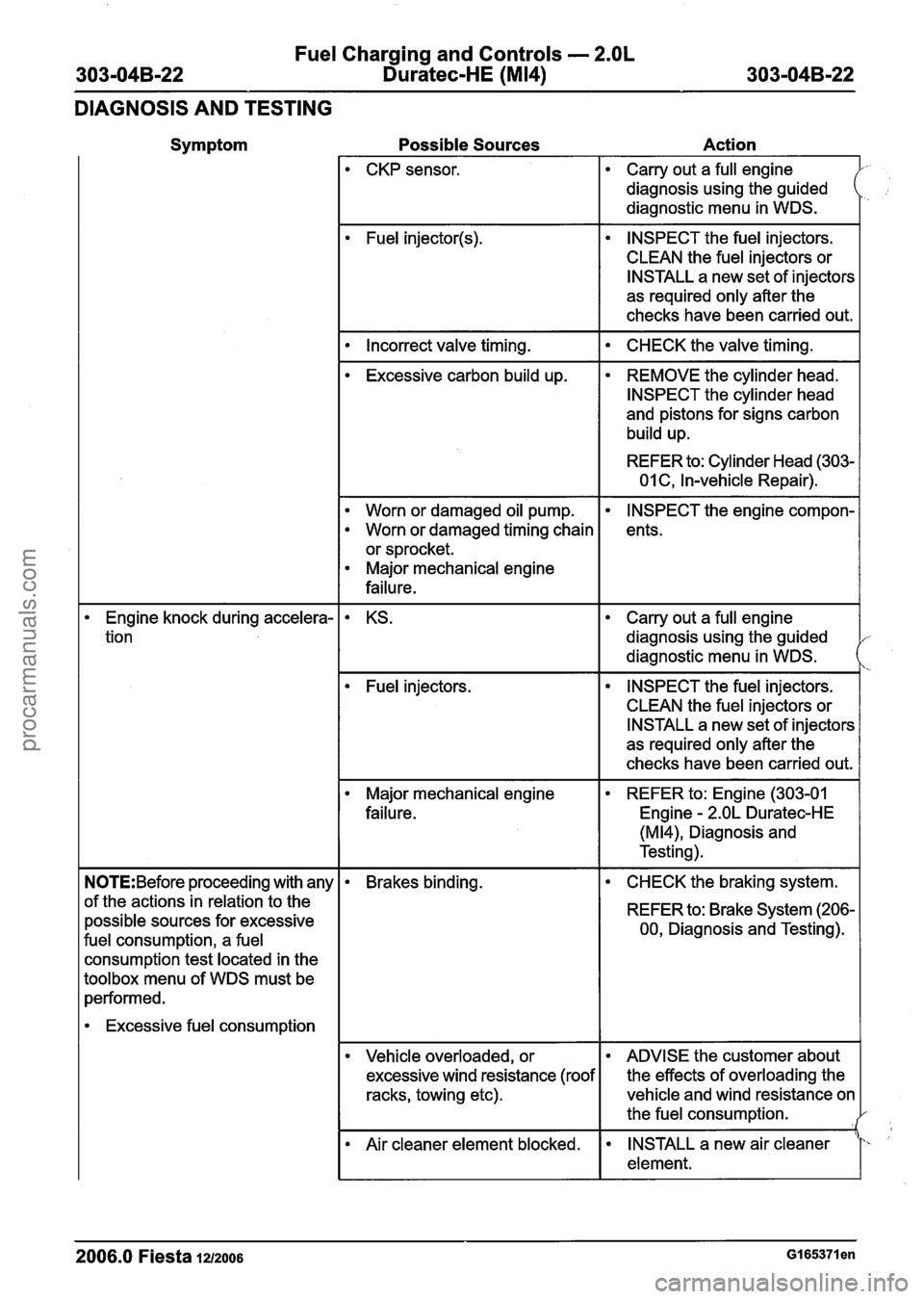
Fuel Charging and Controls - 2.OL
303-04B-22 Duratec-HE (M14) 303-04B-22
DIAGNOSIS AND TESTING
Symptom
Engine knock during accelera-
tion Possible
Sources Action
CKP sensor. Carry out a full engine
diagnosis using the guided
diagnostic menu in WDS.
INSPECT the fuel injectors.
CLEAN the fuel injectors or
INSTALL a new set of injectors
as required only after the
checks have been carried out.
I . Incorrect valve timing. I CHECK the valve timing. I
Excessive carbon build up. REMOVE the cylinder head.
INSPECT the cylinder head
and pistons for signs carbon
build up.
REFER to: Cylinder Head (303-
01 C, In-vehicle Repair).
Worn or damaged oil pump.
Worn or damaged timing chain
or sprocket.
Major mechanical engine
failure. INSPECT
the engine compon- I
ents.
KS.
Fuel injectors. Carry out a full engine
diagnosis using the guided
diagnostic menu in WDS.
INSPECT the fuel injectors.
CLEAN the fuel injectors or
INSTALL a new set of injectors
as required only after the
checks have been carried out.
Major mechanical engine
failure. REFER
to: Engine (303-01
Engine
- 2.OL Duratec-HE
(M14), Diagnosis and
Testing).
N0TE:Before proceeding with any
of the actions in relation to the
possible sources for excessive
fuel consumption, a fuel consumption test located in the
toolbox menu of WDS must be
performed.
Excessive fuel consumption Brakes binding. CHECK
the braking system.
REFER to: Brake System (206-
00, Diagnosis and Testing).
Vehicle overloaded, or
excessive wind resistance (roof
racks, towing etc).
ADVISE the customer about
the effects of overloading the
vehicle and wind resistance on
the fuel consumption.
2006.0 Fiesta 1212006 GI 65371 en
Air cleaner element blocked. INSTALL a new air cleaner .-
element. I
procarmanuals.com
Page 925 of 1226
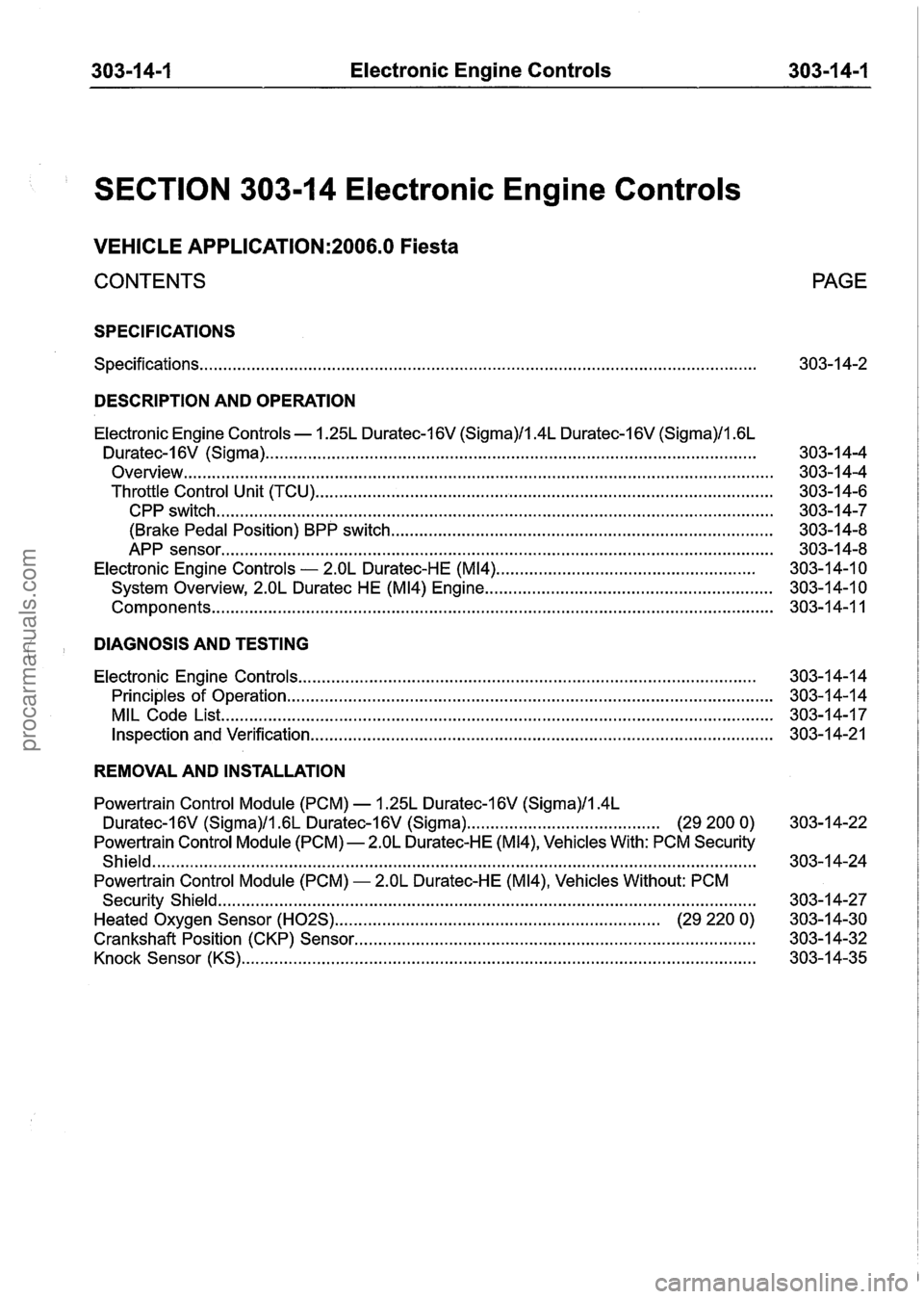
303-1 4-1 Electronic Engine Controls 303-1 4-1
SECTION 303-1 4 Electronic Engine Controls
VEHICLE APPLICATION:2006.0 Fiesta
CONTENTS PAGE
SPECIFICATIONS
Specifications ........................................................................\
.............................................. 303-1 4-2
DESCRIPTION AND OPERATION
Electronic Engine Controls . 1.25L Duratec-16V (Sigma)/l.4L Duratec-I 6V (Sigma)/l . 6L
Duratec-1 6V (Sigma) ........................................................................\
................................
Overview ........................................................................\
.....................................................
Throttle Control Unit (TCU) ........................................................................\
.........................
CPP switch ........................................................................\
..............................................
(Brake Pedal Position) BPP switch ........................................................................\
.........
APP sensor ........................................................................\
.............................................
Electronic Engine Controls - 2.OL Duratec-HE (M14) .......................................................
System Overview, 2.OL Duratec HE (M14) Engine .............................................................
........................................................................\
............................................... Components
DIAGNOSIS AND TESTING
Electronic Engine Controls ........................................................................\
..................... 303-1 4-1 4
Principles of Operation
........................................................................\
............................... 303-1 4-1 4
MIL Code List
........................................................................\
............................................. 303-14-1 7
Inspection and Verification ........................................................................\
.......................... 303-1 4-21
REMOVAL AND INSTALLATION
Powertrain Control Module (PCM) . 1.25L Duratec-1 6V (Sigma)/l.4L
Duratec-16V (Sigma)/l.GL Duratec-1 6V (Sigma) ......................................... (29 200 0) 303-14-22
Powertrain Control Module (PCM)
- 2.OL Duratec-HE (M14), Vehicles With: PCM Security
Shield
........................................................................\
................................................... 303-14-24
Powertrain Control Module (PCM)
- 2.OL Duratec-HE (M14), Vehicles Without: PCM
Security Shield
........................................................................\
.......................................... 303-1 4-27
Heated Oxygen Sensor
(H02S) .................................................................. (29 220 0) 303-14-30
Crankshaft Position (CKP) Sensor
........................................................................\
........... 303-1 4-32
Knock Sensor (KS)
........................................................................\
................................ 303-1 4-35
procarmanuals.com
Page 930 of 1226
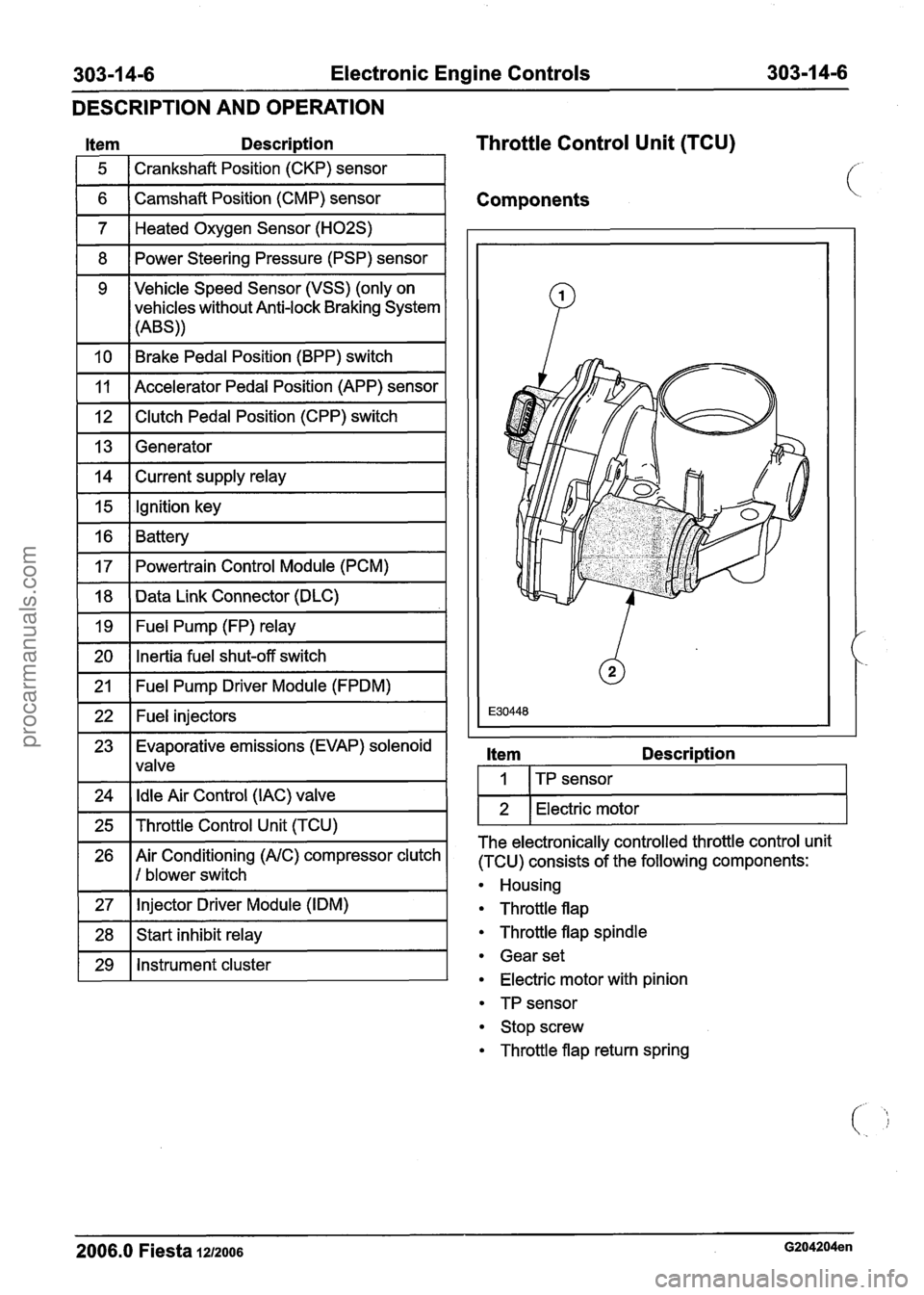
303-1 4-6 Electronic Engine Controls 303-1 4-6
DESCRIPTION
AND OPERATION
Item Descri~tion
1 5 1 Crankshaft Position (CKP) sensor 1
Throttle Control Unit (TCU)
1 6 ( Camshaft Position (CMP) sensor I Components
1 7 1 Heated Oxygen Sensor (H02S) I
1 8 1 Power Steering Pressure (PSP) sensor I
1 10 1 Brake Pedal Position (BPP) switch I
9 Vehicle Speed Sensor (VSS)
(only on
vehicles without Anti-lock Braking System
(ABS))
1 12 1 Clutch Pedal Position (CPP) switch I
11
1 13 1 Generator I
Accelerator Pedal Position (APP) sensor
1 14 1 Current supply relay I
1 15 1 Ignition key I -
16
17
1 20 1 Inertia fuel shut-off switch I
Battery
Powertrain Control Module (PCM)
-
18
19
1 21 1 Fuel Pump Driver Module (FPDM) I
Data Link Connector (DLC)
Fuel Pump (FP) relay
1 22 1 Fuel injectors I
23 Evaporative emissions (EVAP) solenoid
1 lvalve
1 24 1 Idle Air Control (IAC) valve 1
1 25 1 Throttle Control Unit (TCU) I
26 Air Conditioning (AIC) compressor clutch
1 I 1 blower switch
1 27 1 Injector Driver
Module (IDM) I
1 28 1 Start inhibit relay I
1 29 1 Instrument cluster I
Item Descri~tion
I I ITP sensor I
1 2 1 Electric motor I
The electronically controlled throttle control unit
(TCU) consists of the following components:
Housing
Throttle flap
Throttle flap spindle
Gear set
Electric motor with pinion
TP sensor
Stop screw
Throttle flap return spring
2006.0 Fiesta 1212006 G204204en
procarmanuals.com
Page 932 of 1226
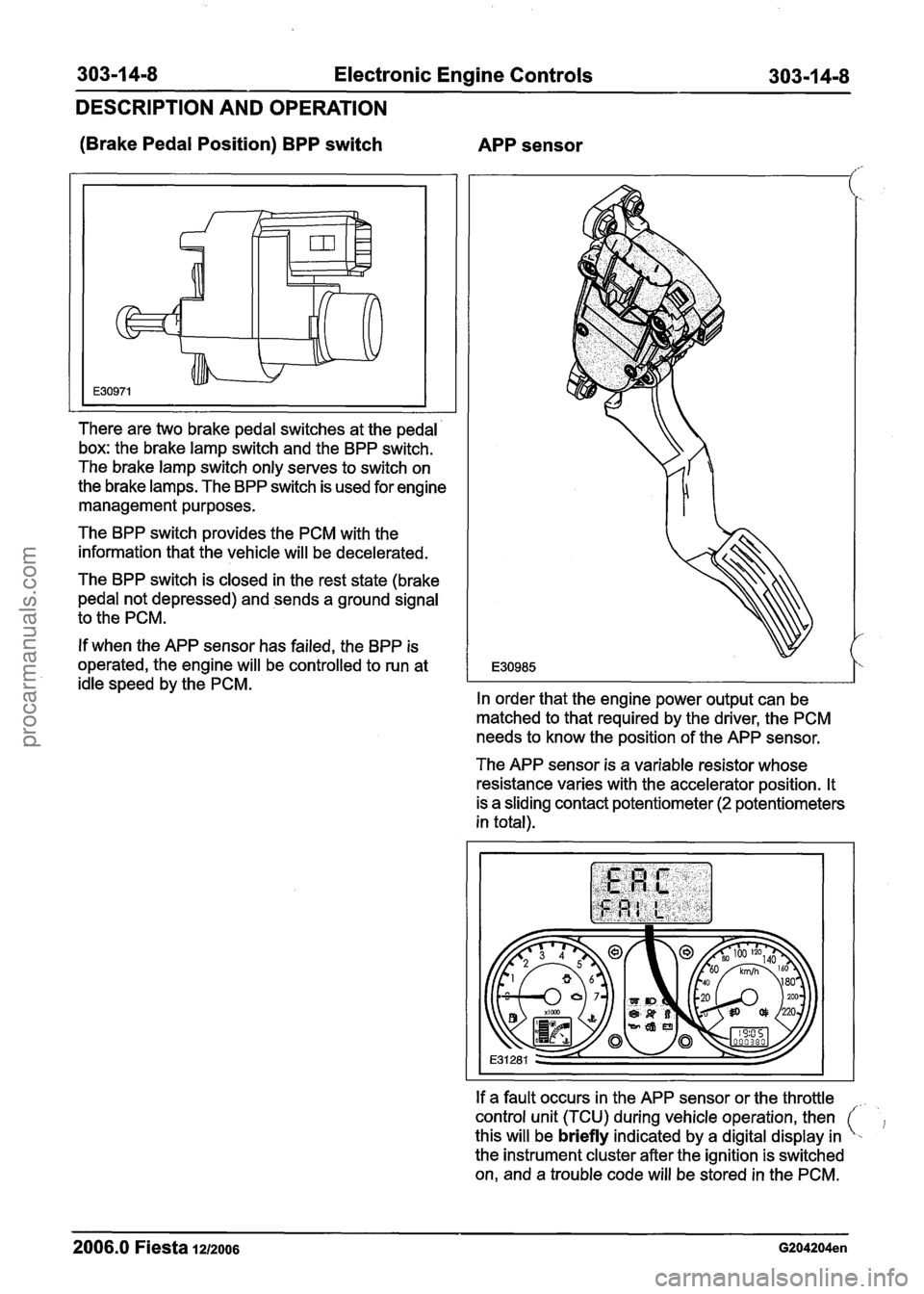
Electronic Engine Controls
DESCRIPTION AND OPERATION
(Brake Pedal Position) BPP switch
APP sensor
There are two brake pedal switches at the pedal
box: the brake lamp switch and the BPP switch.
The brake lamp switch only serves to switch on
the brake lamps. The BPP switch is used for engine
management purposes.
The BPP switch provides the PCM with the
information that the vehicle will be decelerated.
The BPP switch is closed in the rest state (brake
pedal not depressed) and sends a ground signal
to the PCM.
If when the APP sensor has failed, the BPP is
operated, the engine will be controlled to run at
idle speed by the PCM.
In order that the engine power output can be
matched to that required by the driver, the PCM
needs to know the position of the APP sensor.
The APP sensor is a variable resistor whose
resistance varies with the accelerator position. It
is a sliding contact potentiometer
(2 potentiometers
in total).
If a fault occurs in the APP sensor or the throttle
control unit (TCU) during vehicle operation, then
this will be
briefly indicated by a digital display in
the instrument cluster after the ignition is switched
on, and a trouble code will be stored in the PCM.
2006.0 Fiesta 1212006 G204204en
procarmanuals.com
Page 935 of 1226
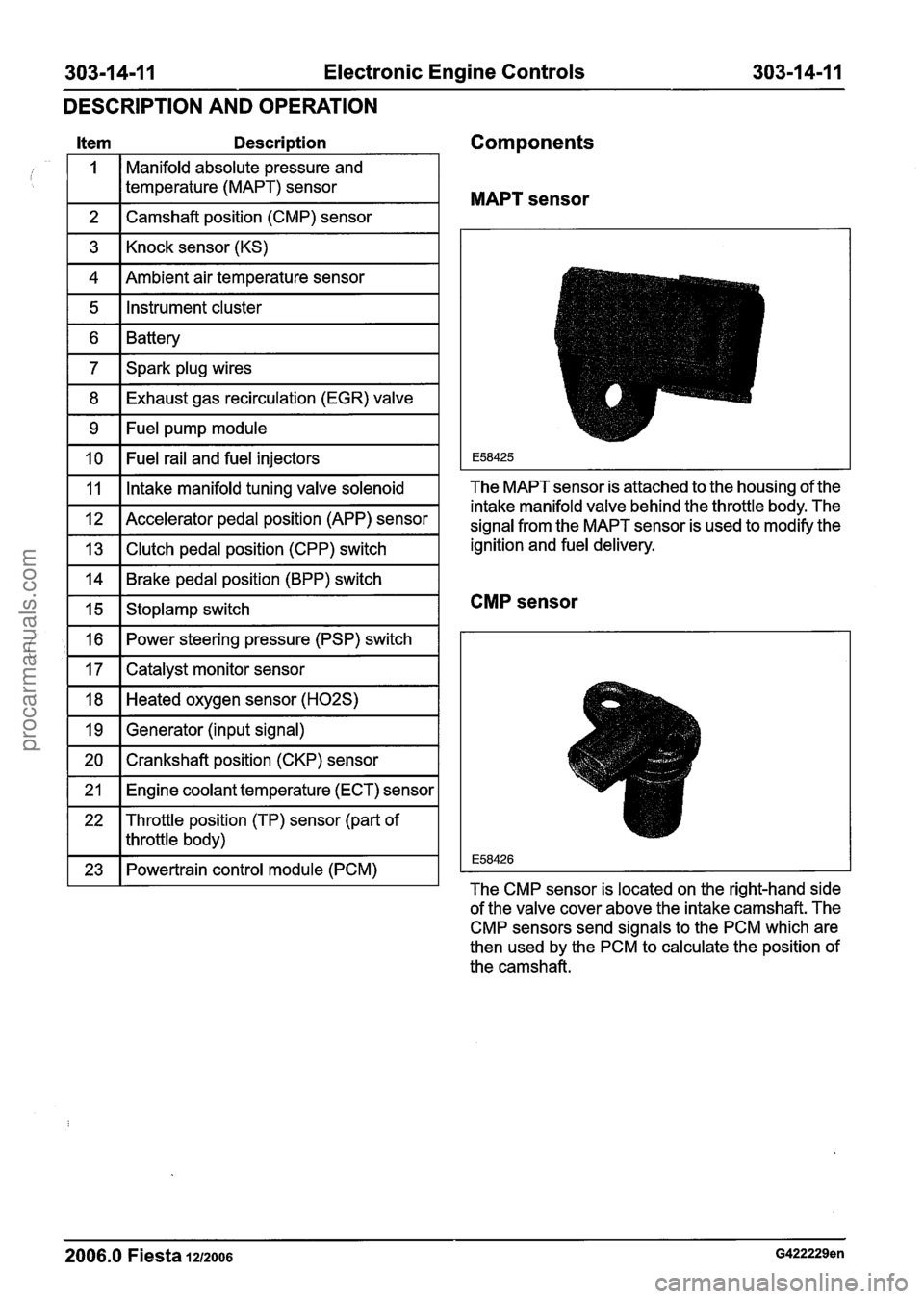
303-1 4-1 1 Electronic Engine Controls 303-1 4-1 I
DESCRIPTION AND OPERATION
Item Description Components
MAPT sensor
Manifold absolute pressure and
temperature (MAPT) sensor
1 2 1 Camshaft position (CMP) sensor I
1 3 1 Knock sensor (KS) I
vl~Ame%air temperature sensor I
1 5 1 Instrument cluster I
1 6 1 Battery I
1 7 1 Spark plug wires I
1 8 1 Exhaust gas recirculation (EGR) valve I
1 9 1 Fuel pump module I
1 10 1 Fuel rail and fuel injectors I
I 11 I Intake manifold tuning valve solenoid The
MAPT sensor is attached to the housing of the
intake manifold valve behind the throttle body. The
signal from the MAPT sensor is used to modify the
ignition and fuel delivery.
1 12 1 Accelerator pedal position (APP) sensor
1 13 1 Clutch pedal position (CPP) switch
1 14 1 Brake pedal position (BPP) switch
CMP sensor 1 15 1 Stoplamp switch
1 16 1 Power steering pressure (PSP) switch I
1 17 1 Catalyst monitor sensor I
FIGted oxygen sensor (H02S) I
1 19 1 Generator (input signal) I
1 20 1 Crankshaft position (CKP) sensor I
1 21 1 Engine coolant temperature (ECT) sensor I
22 Throttle position
(TP) sensor (part of
I I throttle body)
1 23 1 Powertrain control module (PCM) I The CMP sensor is located on the right-hand side
of the valve cover above the intake camshaft. The
CMP sensors send signals to the PCM which are
then used by the PCM to calculate the position of
the camshaft.
2006.0 Fiesta 1212006 G422229en
procarmanuals.com
Page 936 of 1226
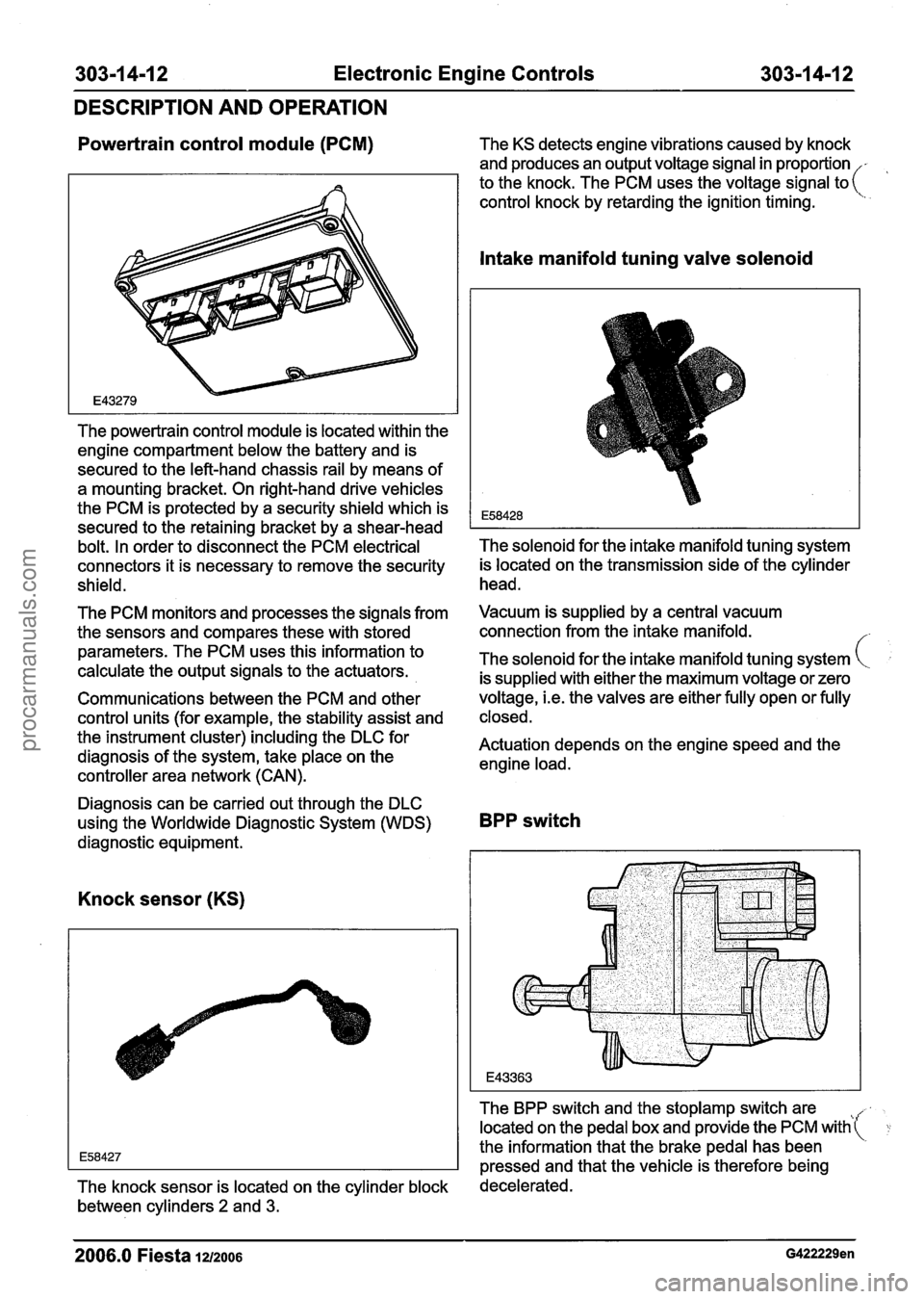
303-1 4-1 2 Electronic Engine Controls 303-1 4-1 2
DESCRIPTION AND OPERATION
Powertrain control module (PCM) The KS detects engine vibrations caused by knock
and produces an output voltage signal in proportion
, to the knock. The PCM uses the voltage signal to(
control knock by retarding the ignition timing.
The powertrain control module is located within the
engine compartment below the battery and is
secured to the left-hand chassis rail by means of
a mounting bracket. On right-hand drive vehicles
the PCM is protected by a security shield which is
secured to the retaining bracket by a shear-head
bolt. In order to disconnect the PCM electrical
connectors it is necessary to remove the security
shield.
The PCM monitors and processes the signals from
the sensors and compares these with stored
parameters. The PCM uses this information to
calculate the output signals to the actuators.
Communications between the PCM and other
control units (for example, the stability assist and
the instrument cluster) including the DLC for
diagnosis of the system, take place on the
controller area network (CAN).
Intake manifold tuning valve solenoid
The solenoid for the intake manifold tuning system
is located on the transmission side of the cylinder
head.
Vacuum is supplied by a central vacuum
connection from the intake manifold.
The solenoid for the intake manifold tuning system
is supplied with either the maximum voltage or zero
voltage,
i.e. the valves are either fully open or fully
closed.
Actuation depends on the engine speed and the
engine load.
Diagnosis can be carried out through the DLC
using the Worldwide Diagnostic System (WDS)
BPP switch
diagnostic equipment.
Knock sensor (KS)
The BPP switch and the stoplamp switch are tt(r located on the pedal box and provide the PCM with
the information that the brake pedal has been
pressed and that the vehicle is therefore being
The knock sensor is located on the cylinder block decelerated.
between cylinders
2 and 3.
2006.0 Fiesta 1212006 G422229en
procarmanuals.com
Page 937 of 1226
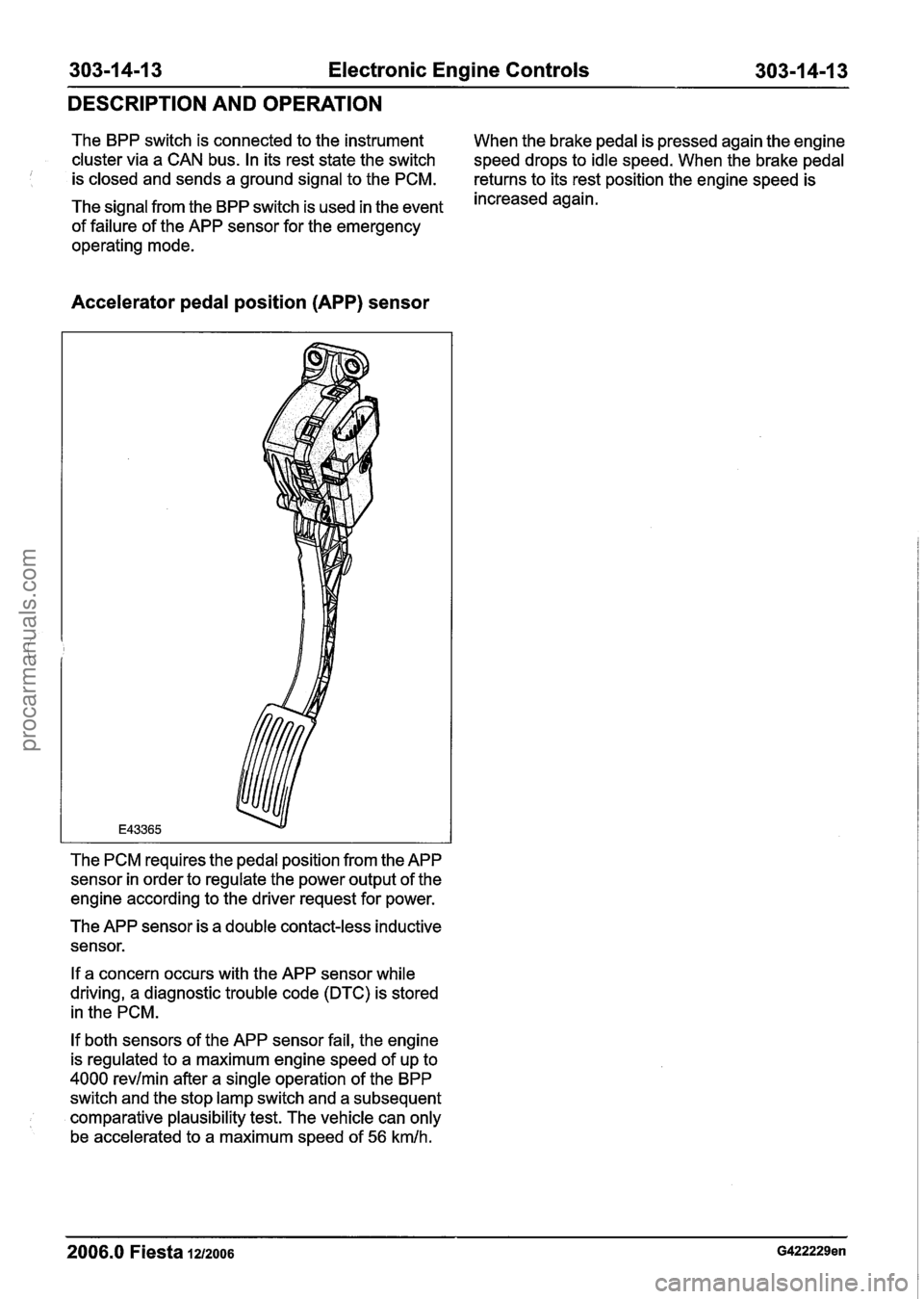
303-1 4-1 3 Electronic Engine Controls 303-1 4-1 3
DESCRIPTION AND OPERATION
The BPP switch is connected to the instrument
When the brake pedal is pressed again the engine
cluster via a CAN bus. In its rest state the switch
speed drops to idle speed. When the brake pedal
is closed and sends a ground signal to the PCM.
returns to its rest position the engine speed is
The signal from the BPP switch is used in the event increased again.
of failure of the APP sensor for the emergency
operating mode.
Accelerator pedal position (APP) sensor
The PCM requires the pedal position from the APP
sensor in order to regulate the power output of the
engine according to the driver request for power.
The APP sensor is a double contact-less inductive
sensor.
If a concern occurs with the APP sensor while
driving, a diagnostic trouble code
(DTC) is stored
in the PCM.
If both sensors of the APP sensor fail, the engine
is regulated to a maximum engine speed of up to
4000 revlmin after a single operation of the BPP
switch and the stop lamp switch and a subsequent
comparative plausibility test. The vehicle can only
be accelerated to a maximum speed of
56 kmlh.
2006.0 Fiesta 1212006 G422229en
procarmanuals.com